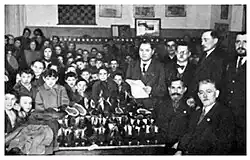
Landsmanshaft (in Yiddish לאַנדסמאַנשאַפט; plural landsmanshaftn) is a Yiddish term used to denote mutual aid societies used in immigrant Jewish communities in the USA, Canada, South America, South Africa, Australia and Israel whose members arrived from the same country, region or town.[1] The term has been imported into Hebrew as well, with the meaning of "association of city expatriates". These associations were founded following mass immigration since the beginning of the 1900s, and underwent dramatic growth between the two world wars. After the Holocaust and with the immigration of many survivors to Israel, Canada and the USA, these societies became very active in responding to the different needs of the survivors, not just financially but also to those related to the person's life events.
Research your ancestors on MyHeritage
Landsmanshaft typesLandsmanshaft types
The associations of city expatriates were established after the city or district of origin of their founders. Among the different services provided by landsmanshaftn were providing interest-free loans to new immigrants, recommending new immigrant for jobs, organizing Shabbat evening meals, and even celebrations for Jewish and Christian (national) holidays. Landsmanschaft organizations also purchased plots of land for a cemetery for their members. They also built Jewish schools and synagogues for union members.
Landsmanshaft and genealogyLandsmanshaft and genealogy
One of the great contributions of the landsmanshaftn for genealogists is the lists of people that included first name, surname, place of birth, names of siblings, date of arrival in the United States or Canada (if applicable) and the name of the guarantor who signed for them to be accepted in the United States or Canada, if applicable. Some others operated as a burial society and thus kept burial records of the deceased, in certain cities with cemetery plots; others may not have cemetery plot records, but may have burial permits or death certificates in their archives.[2]
Landsmanshaft outside of North AmericaLandsmanshaft outside of North America
Landsmanshaft in EuropeLandsmanshaft in Europe
The first documented Landsmanschaft was a medical relief society of immigrants from Cracow, the Hevra Rafuei Chaulim Krakauer, which was founded in 1855. [3] The first Landsmanshaftn were founded in the beginning by Jewish immigrants from Poland[3] based on the German Studentenverbindung (student association) model, to serve their personal needs and were of different types, from chevra kadisha (burial services) to interest-free loans known as gemach. With the great migrations of European Jews between the two world wars and after the Holocaust, they served the newly-arrived Jews as most Jewish immigrants needed to learn a new language, local customs and in many cases, a profession that would enable them to work and support their families in their new country of residence. Their fellow countrymen became translators, instructors and advisors to for the new immigrants. One of the challenges of those who had just arrived by ship from the European shtetlekh was to learn to integrate into the new society. The Landsmanschaft became the new home of the immigrants.
Landmanshaft in Latin AmericaLandmanshaft in Latin America
In most Latin American countries, the different mutual aid Jewish organizations grouped under a nation-wide umbrella organization and were formed along ethnic lines: German, East European, and Sephardic / Syrian-Lebanese, and in some cases the region or city of origin as well. Some of these organizations supported periodical publications in their language of origin, maintained social clubs and helped the jewish community back where they came from.[4][5]
One infamous case of landmanshaftn was the criminal organization Zwi Migdal, founded in Poland in the late 1860s and with most of its operation base in Argentina and Brazil. The original name of the organization was Varsovia Jewish Mutual Aid Society, with Varsovia meaning "Warsaw" in Spanish, indicating the founder's origins; after the Polish consul complained of the use of the name of the country's capital for an organization dealing with human trafficking, the name was changed to Zwi Migdal.[6] As members of the organization were issued a herem (a form of excommunication in Jewish communities) and thus became banned from using community services, the organization purchased a plot of land to establish its own cemetery, offer chevra kadisha services and even built a fancy synagogue in downtown Buenos Aires.[7] Its splinter organization, Ashkenazum, also operated its own cemetery and burial services.[8]
Landsmanshaft todayLandsmanshaft today
These civilian organizations started to decline as their members aged and their children became more and more integrated into the surrounding society, as their children spoke the local language (English, Spanish, Afrikaans, French, Hebrew, or Portuguese) at mother-tongue level and with the increase of social services offered by the local authorities, there was less of a need to maintain an organization that linked them to a place they had never set foot in. Many records of landsmanshaftn were eventually transferred from the New York State Department of Insurance to the archives of YIVO through its Landsmanshaftn Collection Portal Project.[9]
Explore more about LandmandshaftExplore more about Landmandshaft
- Yizkor Book Name Index from JewishGen record collection at MyHeritage
- Canada, Montréal Jewish Synagogue Vital Records collection at MyHeritage
- Last names records collection at MyHeritage
- MyHeritage Adds 28 Collections of Jewish Historical Records on the MyHeritage blog
- Finding Jewish Records in the MyHeritage Search Engine on the MyHeritage Knowledge Base
- How to Research Your Jewish Ancestors on MyHeritage on the MyHeritage Knowledge Base
- Jewish Communal Register (1918) at New York Public Library
- Landsmanshaftn Records at YIVO
- South African Landsmanshaftn Records at LitvakSIG
ReferencesReferences
- ↑ Landsmanschaft — Immigrant Benevolent Organizations, JewishGen
- ↑ YIVO's Landsmanshaftn Collection. YIVO
- ↑ 3.0 3.1 Nathan M. Kaganoff. The Jewish Landsmanschaftn in New York City in the Period preceding World War I. American Jewish History , 176, September 1986, p. 59
- ↑ Landsmannschaften. Jewish Virtual Library.
- ↑ Guy, Donna J (1992). Sex and Danger in Buenos Aires: Prostitution, Family, and Nation in Argentina. University of Nebraska Press. pp. 120–125. ISBN 0803221398.
- ↑ Reinares, Laura Barberán (2014-08-27). Sex Trafficking in Postcolonial Literature: Transnational Narratives from Joyce to Bolaño. Routledge. ISBN 9781317667926.
- ↑ The Story of “Zvi Migdal” – the Infamous Jewish Prostitution Cartel. Anu - Museum of the Jewish People
- ↑ Kupferboim, Rona. Argentine Jewry's dark secret. YNet
- ↑ YIVO INSTITUTE FOR JEWISH RESEARCH’S LANDSMANSHAFTN COLLECTIONS TO BE MORE ACCESSIBLE THROUGH GRANT FROM THE INTERNATIONAL ASSOCIATION OF JEWISH GENEALOGICAL SOCIETIES. YIVO Institute for Jewish Research

